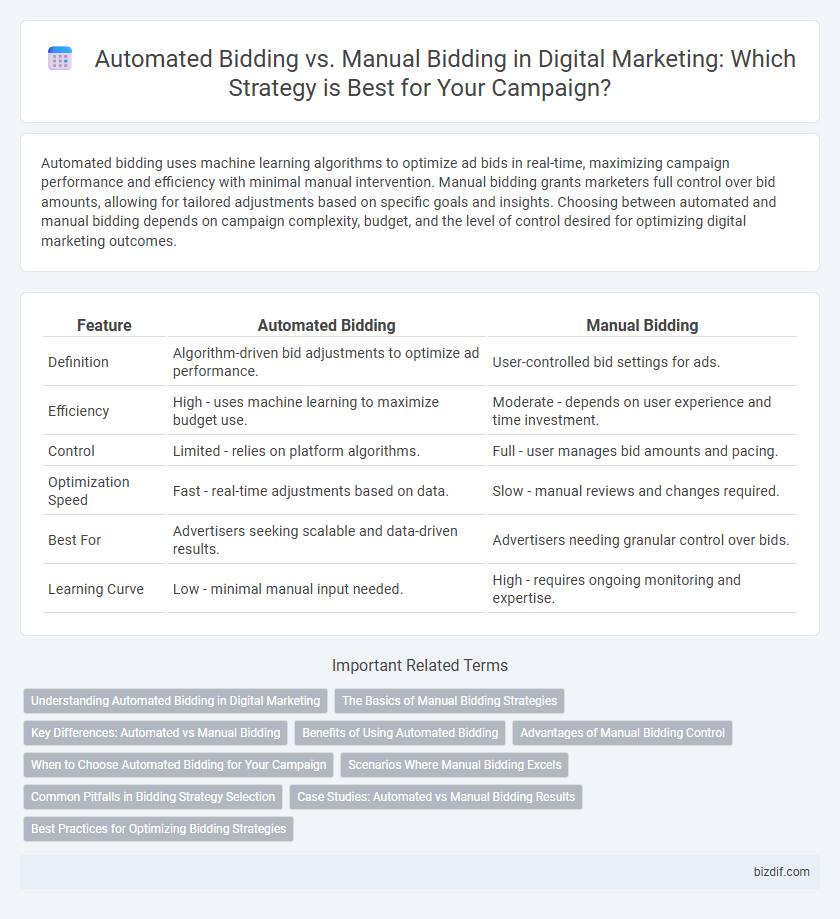Automated bidding uses machine learning algorithms to optimize ad bids in real-time, maximizing campaign performance and efficiency with minimal manual intervention. Manual bidding grants marketers full control over bid amounts, allowing for tailored adjustments based on specific goals and insights. Choosing between automated and manual bidding depends on campaign complexity, budget, and the level of control desired for optimizing digital marketing outcomes.
Table of Comparison
| Feature | Automated Bidding | Manual Bidding |
|---|---|---|
| Definition | Algorithm-driven bid adjustments to optimize ad performance. | User-controlled bid settings for ads. |
| Efficiency | High - uses machine learning to maximize budget use. | Moderate - depends on user experience and time investment. |
| Control | Limited - relies on platform algorithms. | Full - user manages bid amounts and pacing. |
| Optimization Speed | Fast - real-time adjustments based on data. | Slow - manual reviews and changes required. |
| Best For | Advertisers seeking scalable and data-driven results. | Advertisers needing granular control over bids. |
| Learning Curve | Low - minimal manual input needed. | High - requires ongoing monitoring and expertise. |
Understanding Automated Bidding in Digital Marketing
Automated bidding in digital marketing leverages machine learning algorithms to optimize bids in real time, maximizing return on ad spend by adjusting bids based on user behavior, device, location, and time of day. This method reduces manual effort and improves efficiency by continuously analyzing large data sets to predict the likelihood of conversions. Compared to manual bidding, automated bidding enables advertisers to respond dynamically to market changes, enhancing campaign performance across platforms like Google Ads and Facebook Ads.
The Basics of Manual Bidding Strategies
Manual bidding strategies in digital marketing involve setting individual bid amounts for specific keywords or ad placements, allowing precise control over budget allocation and campaign performance. This hands-on approach enables marketers to adjust bids based on real-time data, competitor activity, and targeted audience behavior, optimizing for metrics like click-through rates and conversion costs. Effective manual bids require continuous monitoring and analysis to balance maximizing ad visibility with maintaining efficient spending within campaign goals.
Key Differences: Automated vs Manual Bidding
Automated bidding leverages machine learning algorithms to optimize ad spend by adjusting bids in real-time based on user behavior, conversion likelihood, and competitive landscape. Manual bidding grants advertisers full control over bid amounts, allowing precise budget allocation per keyword or placement, ideal for campaigns with specific performance goals. Automated systems excel in scalability and efficiency, while manual bidding offers granular customization and strategic oversight.
Benefits of Using Automated Bidding
Automated bidding leverages machine learning algorithms to optimize ad spend by adjusting bids in real time based on user behavior, device, location, and time of day, resulting in higher conversion rates and improved return on investment (ROI). It reduces manual effort and analysis, allowing marketers to focus on strategy while the system efficiently manages bids to meet specific campaign goals such as maximizing clicks, conversions, or impression share. The use of data-driven decision-making in automated bidding enhances campaign performance by continuously adapting to market trends and competitor activity without human intervention.
Advantages of Manual Bidding Control
Manual bidding in digital marketing offers precise control over keyword bids, allowing marketers to allocate budgets strategically based on specific campaign goals and performance metrics. This approach enables real-time adjustments to maximize return on investment (ROI) and avoid overspending on underperforming ads. Marketers benefit from granular insights into competitive bidding landscapes, enhancing the ability to optimize ad placements and improve overall campaign effectiveness.
When to Choose Automated Bidding for Your Campaign
Automated bidding is ideal for campaigns aiming to maximize conversions or clicks using machine learning to adjust bids in real-time based on audience behavior and auction dynamics. It excels when managing large-scale campaigns with complex targeting, enabling efficient budget allocation without constant manual adjustments. Choose automated bidding when you have sufficient conversion data and want to leverage Google's algorithms for optimized performance and time savings.
Scenarios Where Manual Bidding Excels
Manual bidding excels in scenarios where precise control over keyword bids is crucial, such as when targeting niche markets or managing high-value campaigns. It allows marketers to adjust bids based on performance data, seasonal trends, and competitor activity to optimize return on ad spend (ROAS). This approach is particularly effective for campaigns with fluctuating budgets or when testing new keywords and ad strategies.
Common Pitfalls in Bidding Strategy Selection
Common pitfalls in bidding strategy selection include over-reliance on automated bidding without understanding its algorithmic adjustments, leading to suboptimal budget allocation. Manual bidding often suffers from inconsistent monitoring and emotional decision-making, reducing campaign efficiency. Balancing data-driven automation with strategic human oversight empowers marketers to optimize ad spend and maximize ROI.
Case Studies: Automated vs Manual Bidding Results
Case studies reveal that automated bidding in digital marketing campaigns often outperforms manual bidding by optimizing bids in real-time based on data-driven insights, leading to higher click-through rates and improved conversion metrics. Brands using automated bidding report significant increases in return on ad spend (ROAS) compared to manually managed campaigns, as algorithms continuously adjust bids for maximum efficiency. Manual bidding may still offer advantages in niche markets requiring granular control, but overall, automated bidding demonstrates superior scalability and performance across diverse digital advertising platforms.
Best Practices for Optimizing Bidding Strategies
Automated bidding leverages machine learning algorithms to optimize ad spend by adjusting bids in real-time based on conversion likelihood and performance data, while manual bidding gives marketers direct control over bid amounts. Best practices for optimizing bidding strategies include setting clear campaign goals, continuously monitoring key performance indicators (KPIs), and using data-driven insights to adjust bids efficiently. Combining automated bidding for large-scale campaigns with manual adjustments for niche targeting ensures improved ROI and campaign effectiveness.
Automated bidding vs manual bidding Infographic

 bizdif.com
bizdif.com